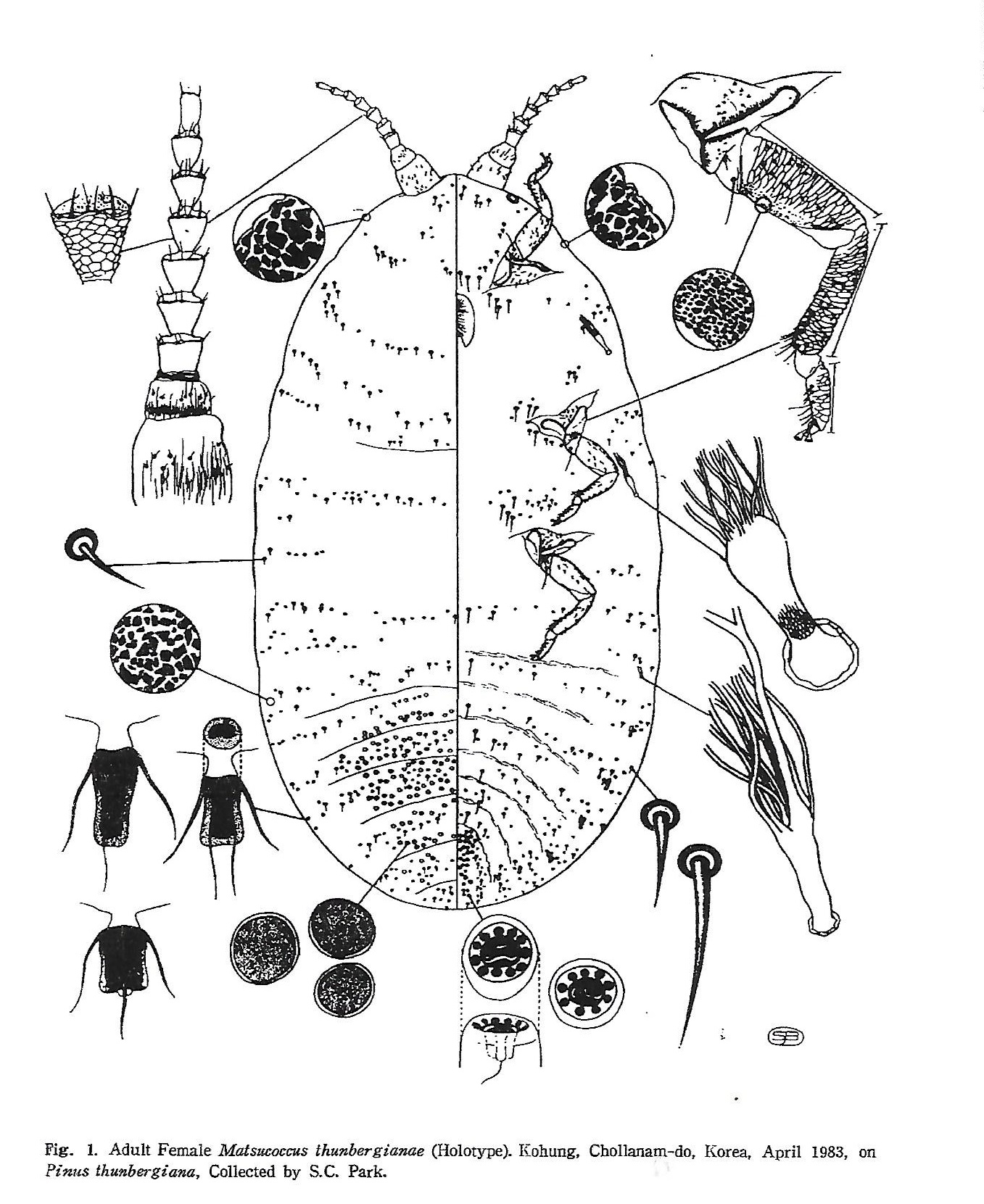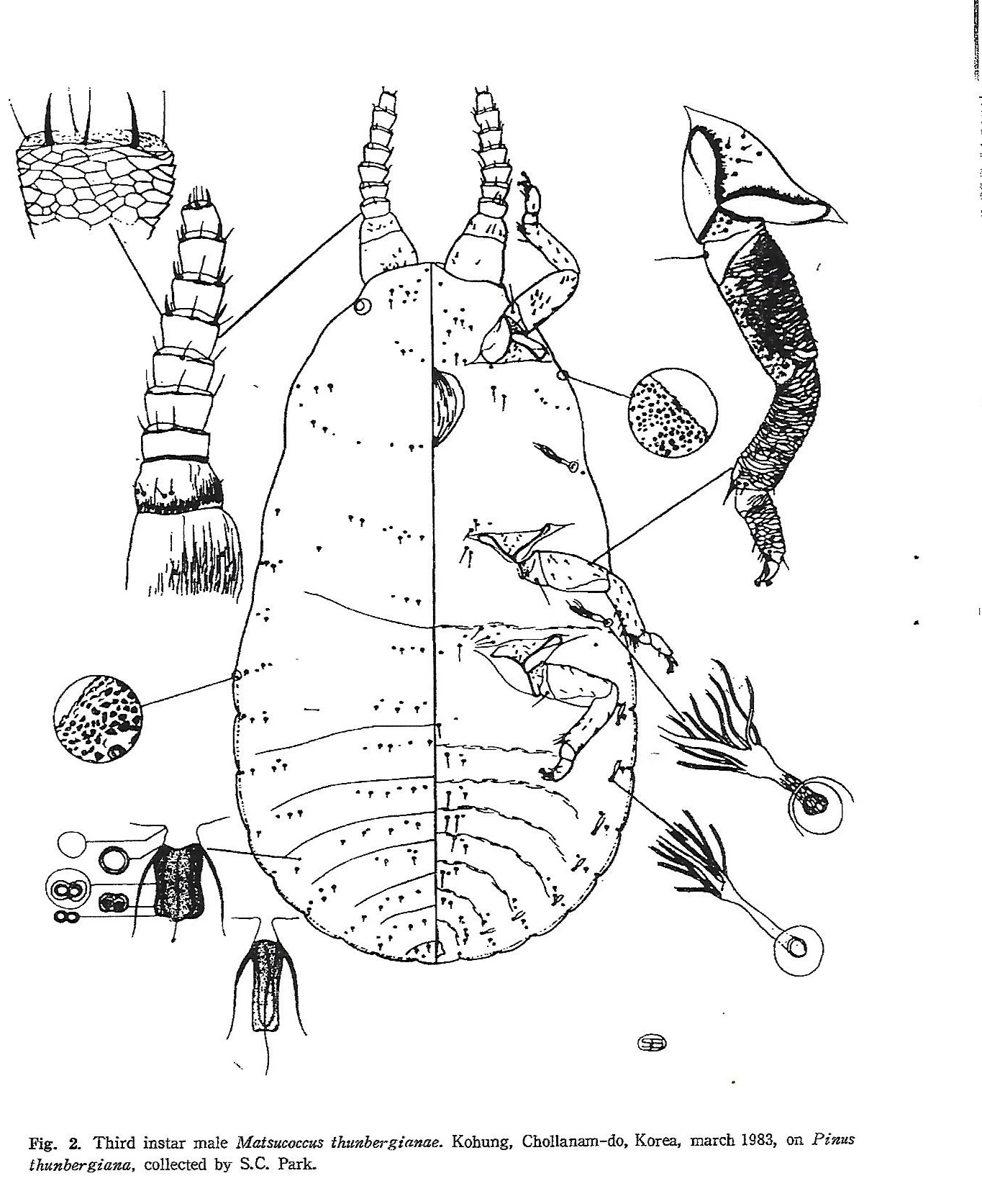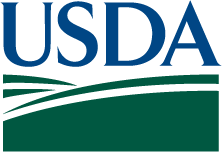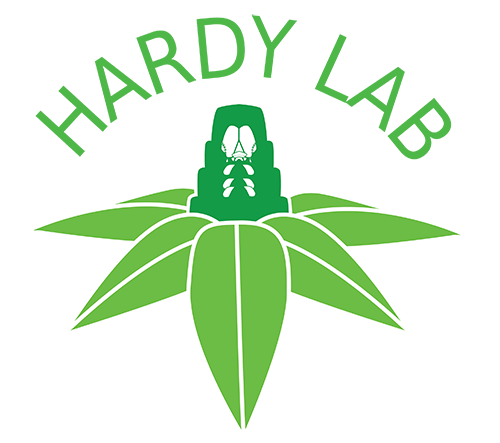Valid Names Results
Matsucoccus matsumurae (Kuwana, 1905) (Matsucoccidae: Matsucoccus)Nomenclatural History
- Xylococcus matsumurae Kuwana 1905: 91. Type data: JAPAN: Tokyo, at Sugamo, on bark of the trunk of pine-tree; collected May 20, 1903.. Syntypes, female, accepted valid name Notes: The type-series was destroyed in an earthquake in 1923 (Kuwana, 1925; Booth & Gullan, 2006). Illustr.
- Xylococcus matsumurae; Kuwana, 1905; Kuwana 1907: 209. subsequent use Notes: Described again as "n. sp.".
- Matsucoccus matsumurae (Kuwana, 1905); Cockerell 1909: 56. change of combination
- Matsucoccus resinosae Bean & Godwin 1955: 166. Type data: USA: Connecticut, Easton, on Pinus resinosa, June 2, 1948; collected George H. Plumb.. Holotype, female, Type depository: Washington: United States National Entomological Collection, U.S. National Museum of Natural History, District of Columbia, USA; junior synonym (discovered by BoothGu2006, 757). Illustr.
- Matsucoccus thunbergianae Miller & Park 1987: 50. Type data: SOUTH KOREA: Collanam, on Pinus thunbergiana, 1984, collected S.C. Park.. Holotype, female, Type depository: Washington: United States National Entomological Collection, U.S. National Museum of Natural History, District of Columbia, USA; junior synonym (discovered by BoothGu2006, 757). Illustr.
- Matsucoccus matsunurae (Kuwana, 1905); Zhao & Li 1989: 13. misspelling of species epithet
- Matsococcus matsumurae; Gertsson 2001: 125. misspelling of genus name
Common Names
- Japanese pine bast scale YoungWu1983
- red pine scale BeanGo1955 Koszta1996
- Cochinilla del pino de Japón KondoGuMe2022
- matsu-moguri-kaigaramushi KondoGuMe2022
Ecological Associates
Hosts:
Families: 1 | Genera: 1
- Pinaceae
- Pinus | Kuwana1905
- Pinus banksiana | ShiGaDa2024
- Pinus densiflora | BeanGo1971
- Pinus luchuensis | KondoGuMe2022
- Pinus massoniana | LiuXiYa2014
- Pinus parviflora | EFSA2024f
- Pinus resinosa | BeanGo1955
- Pinus sylvestris | ShiGaDa2024
- Pinus tabuliformis | BeanGo1971 KondoGuMe2022 LiZh1997 LiuXiYa2014
- Pinus taiwanensis | KondoGuMe2022
- Pinus thunbergii | BeanGo1971 MillerPa1987 | (= Pinus thunbergiana)
Foes:
Families: 15 | Genera: 37
- Anthocoridae
- Anthocoris chibi | LiuXiYa2014
- Anthocoris japonicus | LiuXiYa2014
- Dufouriellus ater | LiuXiYa2014
- Elatophilus | ChengMiGe1983 MendelCaPo1991
- Elatophilus inimicus | MendelCaPo1991 NelsonLaGr2002
- Elatophilus matsucocciphagus | KondoGuMe2022
- Elatophilus nipponensis | LiuXiYa2014
- Orius | KondoGuMe2022
- Orius sauteri | KondoGuMe2022
- Anystidae
- Anystis baccarum | UlgentSzUy2013
- Cecidomyiidae
- Lestodiplosis | LiuXiYa2014
- Oligotrophus | LiuXiYa2014
- Chrysopidae
- Chrysopa shansiensis | LiuXiYa2014
- Chrysopa formosa | LiuXiYa2014
- Chrysopa intima | LiuXiYa2014
- Chrysopa kulingensis | LiuXiYa2014
- Chrysopa phyllochroma | LiuXiYa2014
- Chrysopa septempunctata | KondoGuMe2022
- Chrysopa sinica | LiuXiYa2014
- Coccinellidae
- Amatis ocellata | KondoGuMe2022 LiuXiYa2014
- Calvia chinensis | KondoGuMe2022
- Chilocorus renipustulatus | LiuXiYa2014 | (= Chilocorus kuwanae)
- Coccinula quatuordecimpustulata | LiuXiYa2014
- Coelophora biplagiata | LiuXiYa2014
- Cryptogonus horishanus | LiuXiYa2014
- Exochomus mongol | KondoGuMe2022
- Harmonia axyridis | ChoiLeKi1995 McClur1986
- Harmonia obscurosignata | LiuXiYa2014
- Lemnia saucia | KondoGuMe2022
- Novius koebelei | KondoGuMe2022
- Oenopia scalaris | GaoChZh2025
- Propylea japonica | KondoGuMe2022 LiuXiYa2014
- Propylea quatuordecimpunctata | LiuXiYa2014
- Scymnus folchinii | GaoChZh2025
- Scymnus frontalis | LiuXiYa2014
- Sticholotis punctata | LiuXiYa2014
- Synharmonia bissexnotata | LiuXiYa2014
- Cordycipitaceae
- Lecanicillium fungicola | GaoChZh2025 | 'HEB02'
- Formicidae
- Formica japonica | KondoGuMe2022
- Formica lemani | HuoLiZh1983 KondoGuMe2022
- Formica rufibarbis | KondoGuMe2022 LiuXiYa2014
- Iridomyrmex anceps | KondoGuMe2022
- Pheidole | LiuXiYa2014
- Polyrhachis dives | LiuXiYa2014 | (= Polyrhachis affinis)
- Hemerobiidae
- Hemerobius humulinus | KondoGuMe2022
- Hemerobius lacunaris | KondoGuMe2022
- Sympherobius fallax | LiuXiYa2014 | (= "Sympherobius amicus)
- Sympherobius luojiaensis | KondoGuMe2022
- Sympherobius tessellatus | LiuXiYa2014 | (= Sympherobius weisong) and (= Sympherobius matsucocciphagus)
- Inocelliidae
- Inocellia crassicornis | LiuXiYa2014
- Inocellia sinensis | LiuXiYa2014
- Lycosidae
- Lycosa coelestis | KondoGuMe2022
- Miridae
- Cimidaeorus nigrorufus | LiuXiYa2014
- Oxyopidae
- Oxyopes sertatus | KondoGuMe2022
- Phlaeothripidae
- Karnyothrips flavipes | KondoGuMe2022
- Reduviidae
- Velinus nodipes | KondoWa2022
- Syrphidae
- Betasyrphus serarius | KondoGuMe2022
Associates:
Families: 2 | Genera: 2
- Cordycipitaceae
- Lecanicillium lecanii | KondoGuMe2022
- Nectriaceae
- Fusarium incarnatum–equiseti | KondoGuMe2022
Geographic Distribution
Countries: 5
- China
- Anhui (=Anhwei) | LiuXiYa2014
- Beijing (=Peking) | YoungMiMc1984 YoungQi1983
- Guizhou (=Kweichow) | ShiGaDa2024
- Jiangsu (=Kiangsu) | ShiGaDa2024
- Jilin (=Kirin) | LiuXiYa2014
- Liaoning | LiuXiYa2014
- Shandong (=Shantung) | LiuXiYa2014
- Shanghai | LiuXiYa2014
- Zhejiang (=Chekiang) | LiuXiYa2014
- Japan | Kawai1980 Kuwana1917a
- South Korea | ESKSAE1994 MillerPa1987
- Sweden | KondoGuMe2022
- United States
- Connecticut | BeanGo1955 Koszta1996
- Massachusetts | MechAsCr2013
- New Hampshire | MechAsCr2013
- New Jersey | BeanGo1971 Koszta1996
- New York | BeanGo1971 Koszta1996
- Pennsylvania | MechAsCr2013
- Rhode Island | MechAsCr2013
Keys
- AhmedRaMo2020: pp.8 ( Adult (F) ) [Eastern U.S.]
- Koszta1996: pp.44 ( Adult (F) ) [Northeastern North America]
- TangHa1995: pp.101-102 ( Adult (F) ) [Palearctic]
- MillerPa1987: pp.54-55 ( Adult (F) ) [World]
- RayWi1984: pp.768-769 ( Adult (F) ) [North America]
- Boraty1952a: pp.321-324 ( Adult (F) ) [World]
- Morris1928: pp.53 ( Immature (F) ) [Species of Matsucoccus.]
Remarks
- Systematics: Danzig (1972a: 261-263) recorded under (M. matsumurae material from Russia (Leningrad region and Primorye Territory) and from Kazakhstan. Later, Danzig (1980b) indicated that the material recorded from Russia (Leningrad region and Primorye Territory) belongs to M. matsumurae, while the record from Russia, Primorye Territory belongs to M. koraiensis. Young et al. (1976) recorded and described M. koraiensis from the Liaoning, Shantung, Kiangsu and Chekiang provinces in China. However, Tang & Hao (1995) interpreted that this species does not occur in China. McClure (1983a) suggested that M. resinosae and M. matsumurae are synonyms, but did not formally introduce the synonymy. Based on the morphological and molecular evidence, Choi, et al., 2019 corroborates the results of Booth & Gullan (2006) who synonymized Matsucoccus thunbergianae with M. matsumurae.
- Structure: Young & Wu (1983) described the ultrastructure of sperm bundle. Young & Yao (1986) studied and described the ultrastructure and histology of the dorsal cicatrices in the adult females from Chinese population of this species. They demonstrated that the gland cells undergo distinct changes after mating, and hypothesized that the dorsal cicatrices function in the secretion of the sex pheromone. Miller & Park (1987) reported on seasonal differences in numbers and measurements of certain morphological characters of the adult female.
- Biology: Young & Qi (1983) demonstrated that extracts of the female sex pheromone attracted adult males of this species, and also at a lower rate the adult males of M. massonianae. Young et al. (1984) found that adult males of M. resinosae Bean & Godwin, and adult males of Japanese M. matsumurae are strongly attracted to the sex pheromone of adult females of Chinese populations of M. matsumurae. The results of these bioassays provided evidence that M. resinosae may be a junior synonym of M. matsumurae (Young et al., 1984).Develops two annual generations in USA, Connecticut (Bean & Godwin, 1955, 1971). Young et al. (1984) found that adult males of M. resinosae Bean & Godwin, and adult males of Japanese M. matsumurae are strongly attracted to the sex pheromone of adult females of Chinese populations of M. matsumurae. The results of these bioassays provided evidence that M. resinosae may be a junior synonym of M. matsumurae (Young et al., 1984). Park et al. (1986) found in laboratory bioassays, that males of Matsucoccus resinosae from Pinus resinosa in New York, and males of Matsucoccus sp. from Pinus thunbergiana in Korea, were strongly attracted to crude hexane extract of M. resinosae females. Males of M. resinosae responded strongly to extracts of Matsucoccus sp. females. Males of both species responded similarly to gas chromatographic fractions and subfractions of a pentate extract of M. resinosae females. Sex pheromones of these two species appear to be the same or very similar (Park et al., 1986). This species is regarded a pest of pine trees in eastern USA. Park et al. (1986) found in laboratory bioassays, that males of Matsucoccus resinosae from Pinus resinosa in New York, and males of Matsucoccus sp. from Pinus thunbergiana in Korea, were strongly attracted to crude hexane extract of M. resinosae females. Males of M. resinosae responded strongly to extracts of Matsucoccus sp. females. Males of both species responded similarly to gas chromatographic fractions and subfractions of a pentate extract of M. resinosae females. Sex pheromones of these two species appear to be the same or very similar (Park et al., 1986).
- Economic Importance: Lee et al. (1991) reported on chemical control of this pest in South Korea. M. matsumurae was responsible for foliage discoloration and mortality of plantation-grown P. resinosa in Connecticut. (McClure, 1963) Through laboratory and field bioassays, researchers have identified the pheromone of M. matsumurae as (2E,4E)-4,6-10,12-tetramethyl-2,4- tridecadiene-7-one (matsuone). Later, it was determined the absolute configuration of the natural sex pheromone as (2E,4E, 6R, 10R)-4,6-10,12- tetramethyl-2,4-tridecadiene-7-one. The synthesis of the sex pheromone has made it available for monitoring the scale in the Korean forest. (Kim, et al., 2016)
- General Remarks: Description and illustration of adult female by Kuwana (1905, 1907), Morrison (1928), Bean & Godwin (1955) (as M. resinosae), Young et al. (1976), Miller & Park (1987) (as M. thunbergianae), Tang & Hao (1995), Kosztarab (1996) and by Foldi (2004). The redescription by Herbert (1921), under the name Matsucoccus matsumurae is a misidentification of M. gallicolus; see discussion by Booth & Gullan (2006). Detailed SEM and TEM analyses and photographs of the antennae of the first instar nymphs, adult females and third instar male nymphs can be found in Wang, et al., 2016. The whole genomic DNA of M. matsumurae was sequenced in Hu, et al., 2022, and they stated that a phylogenetic analysis of the mitochondrial DNA suggests that Matsucoccidae is a more ancient taxon than Coccidae.
Illustrations
Citations
- Abraha1977: distribution, economic importance, host, life history, 1-2
- AhmedRaMo2020: DNA, diagnosis, key,
- Aldric1996: chemical ecology, 199-233
- AndersFoKe1976: distribution, host, life history, 1-5
- Bean1956: distribution, economic importance, host, life history, taxonomy, 1-4
- BeanGo1955: description, distribution, economic importance, host, illustration, life history, taxonomy, 164-176
- BeanGo1971: distribution, economic importance, host, life history, taxonomy, 1-6
- BenDov2005a: catalog, distribution, economic importance, host, taxonomy, 129-131, 134-138
- BhoiSaMa2024: control, economic importance, host, 389
- BodenhNe1955: taxonomy, 10
- BoothGu2006: molecular biology, taxonomy, 749-760
- Boraty1952: taxonomy, 323
- BrancoFrOf2005: biological control, chemical ecology, life history, 234-235
- BrancoLeFr2006: biological control, chemical ecology, 1577-1586
- Buchne1966: life history, structure, 280-281
- ChengMiGe1983: biological control, economic importance, 11-30
- ChoiChKi2019: DNA, life cycle, phylogeny, taxonomy,
- ChoiLe2022: phylogeny, 358
- ChoiLeKi1995: biological control, distribution, host, 115-118
- ChoiLeSh1997: chemical control, distribution, host, 82-86
- ChoiLeSh1998: distribution, ecology, host, life history, 146-150
- ChungBaPa2000: distribution, host, 85-89, 306-309
- Cocker1909: taxonomy, 55-56
- CollinCo1958: biological control, distribution, economic importance, host, 335-340
- CywinWeKa1991: chemical ecology, chemistry, 2953-2955
- Danzig1972a: distribution, host, taxonomy, 261-263
- Doane1965: distribution, economic importance, host, 1-7
- Dunkel1999: chemical ecology, chemistry, 251-276
- DunkelMeGr1996: biological control, chemistry, life history, 489-494
- DunkelMoMe2001: biological control, chemistry, life history, physiology, 391-396
- EFSA2024f: biology, diagnosis, distribution, economic importance, host, life cycle, taxonomy,
- ESKSAE1994: distribution, list, 110
- Floren1917: taxonomy, 148
- Foldi1998: catalog, 429
- Foldi2001a: taxonomy, 208
- Foldi2005: description, distribution, host, illustration, taxonomy, 160-162
- FrancoCoLu2021: reproduction, 253
- Frank2021: ecology, 3
- Gao1987: biological control, 271-276
- GaoChZh2025: behavior, distribution, entomopathogenic fungi, host, illustration, importance, phenology, reproduction,
- Gavril2018: illustration, morphology, 85
- Gertss2001: distribution, 123-130
- GrimblPa1976: ecology, life history, 1-3
- GuoYaFa2005: distribution, host, life history, 17-19
- HeZh2001: chemical control, distribution, host, 24-26
- Herber1921FBB: description, distribution, host, taxonomy, 15-19
- HibbarLaPa1991: chemical ecology, chemistry, 89-102
- HongNaKi2021: control,
- HouWeZh2023: phylogeny, 343, 344, 346
- HuYuZh2022: DNA, phylogenetics,
- HuoLi1990: distribution, economic importance, host, 21-22
- HuoLiZh1983: biological control, distribution, host, life history, 243-245
- Jashen1999: distribution, host, taxonomy, 44
- Kawai1972: distribution, host, 3
- Kawai1980: distribution, host, taxonomy, 90
- Kaweck1965a: structure, taxonomy, 205-211
- KimKiMa2016: economic control, 899-902
- KishiAs2003: distribution, host, life history, 131-135
- KondoGuMe2022: biology, control, diagnosis, distribution, host, illustration, 48-50
- KondoWa2022a: distribution, host, list, 22
- Koszta1996: description, distribution, host, illustration, taxonomy, 46-50
- Kozarz1992: distribution, host, taxonomy, 143-144
- KurosaTaDu2000: chemistry, 55-66
- Kuwana1905: description, distribution, host, illustration, taxonomy, 91-95
- Kuwana1907: description, distribution, host, illustration, taxonomy, 209-212
- Kuwana1917a: distribution, taxonomy, 165
- LanierQiWe1989: chemistry, taxonomy, 1645-1659
- LeeKiCh2018: control,
- LeeKwCh2019: control,
- LeePaPa1991: chemical control, distribution, economic importance, host, 140-145
- LeeWiPa2013: distribution, physiology, 349-356
- LiHaXu2005: distribution, ecology, economic importance, host, 95-100
- LiLiYa2025: control, economic importance, 2, 11
- LiZh1997: biological control, distribution, host, life history, 307-320
- LiZhHa1980: biological control, distribution, economic importance, host, life history, 1-27
- LinXu1993: chemical ecology, chemistry, 5931-5934
- LinXu1996: chemical ecology, chemistry, 375-380
- LiuXiYa2014: biological control, dispersal, distribution, genetics, illustration, life cycle, morphology, natural enemies,
- Mao1986: distribution, host, life history, 201-204
- McClur1976: distribution, ecology, host, life history, 943-947
- McClur1977b: distribution, ecology, host, life history, 789-795
- McClur1981a: distribution, ecology, economic importance, host, life history, 4-6
- McClur1982: distribution, host, 150-157
- McClur1983: distribution, ecology, host, life history, 710-718
- McClur1983a: distribution, ecology, host, life history, 761-765
- McClur1985a: distribution, ecology, host, life history, 535-538
- McClur1986: biological control, distribution, ecology, host, life history, 976-983
- McClur1990: distribution, ecology, host, life history, 672-676
- McClur1991: distribution, ecology, host, life history, 256-270
- McClurDaDe1983: biological control, chemical control, distribution, ecology, host, life history, 440,475-477
- McInty1958: distribution, economic importance, host, 369-371
- MechAsCr2013: distribution, host, 2391-2392
- MendelAsDu2004: biological control, chemical ecology, 134-140
- MendelCaPo1991: biological control, distribution, host, 502-507
- MillerPa1987: description, distribution, host, illustration, taxonomy, 49-62
- MingGeZh1983: biological control, 19-29
- MoriHa1993a: chemical ecology, chemistry, 993-1001
- Morris1928: description, distribution, host, illustration, taxonomy, 13,48-53,225
- NelsonLaGr2002: biological control, distribution, host, 284-285
- Park1988: chemical ecology, life history, 1-179
- Park1996: chemical ecology, chemistry, distribution, ecology, host, life history,
- ParkAb1991a: chemical ecology, chemistry, physiology, 94-99
- ParkWeAb1986: chemistry, life history, taxonomy, 609-617
- ParkWiKi1994: chemical ecology, chemistry, control, physiology, 2185-2196
- ParkWiKi2000: chemical ecology, chemistry, physiology, 135-140
- ParkWiMo1994: chemical ecology, 250-256
- QiFuXu1984: chemistry, ecology, life history, 49-52
- QiFuXu1985: chemistry, life history, 13-17
- QiYaZh1983: chemistry, life history, 21-28
- Rieux1975: distribution, host, taxonomy, 157-168
- SchmutKlLu1957: distribution, economic importance, host, 420
- ShenLoJi2003: chemical control, distribution, host, 27-28
- ShiGaDa2024: climate change, distribution, host distribution,
- ShinLeLe2003: distribution, economic importance, host, 1-10
- Smetni1991: chemistry, 92-129
- Stephe1977: ecology, life history, 4-5
- StepheAy1978: ecology, life history, 556-563
- Suh2020: distribution, host, 15
- Taketa1972: distribution, ecology, host, life history, 1-9
- Tang1978: description, taxonomy, 164-170
- TangHa1995: description, taxonomy, 111,551-558
- TangWuLi1997: taxonomy, 17-23
- VeaGr2015: phylogeny, 62
- VeaGr2016: evolution, 4
- WangXiZh2016: morphology, structure, 281-293
- WatanaWaKi1997: chemical ecology, chemistry, 127-130
- Wei2002: economic importance, 66-70
- WiPa2001: chemistry, ecology, life history, 139-145
- Xie1998: description, distribution, host, illustration, taxonomy, 16-19
- XuQiGe2012: dispersal, distribution, list of species, 4, A371
- XuReLu2025: distribution, 68
- XuYaZh1985: distribution, host, life history, 389-395
- Yang1982: distribution, host, 21
- Young1979: distribution, host, life history, taxonomy, 108-114, 183
- Young1980: taxonomy, 183
- YoungHuRe1976: description, distribution, host, illustration, taxonomy, 199-204
- YoungHuRe1980: description, taxonomy, 42-46
- YoungMiMc1984: chemistry, life history, taxonomy, 1-20
- YoungQi1983: chemistry, ecology, life history, taxonomy, 273-278
- YoungWu1983: structure, 263-265
- YoungYa1986: life history, physiology, structure, 253-260
- YoungYa1987: life history, structure, 79-82
- Zhao1987: biological control, 126-127
- Zhao1988: biological control, distribution, host, 1-109
- ZhaoLi1989: biological control, distribution, host, taxonomy, 7-13
- ZhaoLiXu2025: phylogeny, 3




